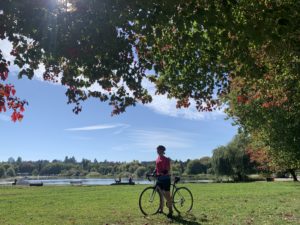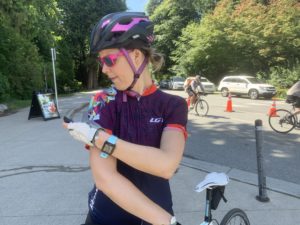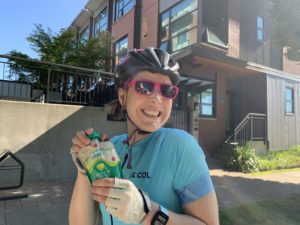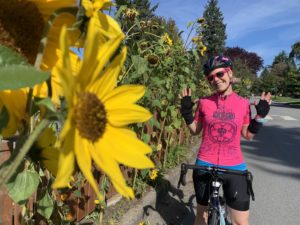Let the training begin – this type-1 diabetes dietitian, with T1D, has a cycling fondo booked in BC in T minus 4 months!
After 2 years of no running races or cycling events, I have entered the Okanagan Gran Fondo for this July.
It’s the second bike fondo I’ve ever done; the first was in pursuit of a Tiffany’s necklace 🙂 I’ll be doing this one alongside my husband, which I’m super excited for.
But also nervous.
The distance is 120 km. I’ve only done that distance once previously and we had a LOT of snack breaks in between. This fondo will be very different from that.
So you know what that means? I need to up my training and nutrition game.

Strategizing the physical component
Currently my exercise regime is about 4-6 days a week, which includes:
- Two to three intense 30-45 minute bike rides on the Peloton
- One 20-30 minute recovery ride
- 2 strength workouts, mostly targeting the arms because I hate overly fatiguing my legs (I know)
- And slowly building up to one 30-minute outdoor run a week.
Most of this is all inside exercise, and short in duration.
That needs to change.
A 120 km fondo is going to take me several hours, and I need to prepare for that.
Starting in April, I will be dedicating one day a week to outdoor bike rides that are a minimum of 4 hours in duration to start.
I am also incorporating a minimum of 5-10 minute core exercises into all my workouts to improve my core stability, which should benefit my cycling overall. This, I recognize, is going to be a challenge for me, because I do NOT enjoy core work! But it is a challenge I am willing to accept if it brings me success on the bike.

Strategizing the nutrition component
My short duration workouts haven’t had to rely heavily on nutrition, beyond managing blood sugars. But that changes with longer distances and longer times on the bike. I need to think of nutrition not only for blood sugar management, but also for performance outcomes.
The general recommendation for aerobic workouts (cycling, running, swimming, hiking, etc.) for people with type-1 diabetes is:
- 30-60 grams fast-acting carbs per hour for durations lasting 1-2.5 hours
- 60-90 grams fast-acting carbs per hour for durations lasting greater than 2.5 hours
However, if there’s lots of insulin circulating during the workout, the general recommendation is:
- Up to 75 grams fast-acting carbs per hour for durations lasting 1-2.5 hours
For this recommendation, you’ve pretty much just had a meal 1-2 hours earlier and taken your full dose insulin.
Now, these are general recommendations largely based on a non-diabetes population. They may not work for me or my diabetes. In fact, in the past, I know that they haven’t. But essentially, I am starting over with this new training plan. And that means, I need to work on my trial and error strategies using some of these foundational recommendations as a starting point.

Trial and Error for the Diabetes Win
What does a trial and error strategy look like for diabetes and sport?
For this T1D dietitian, it’s pretty simple. I document and review everything. That includes:
- Blood sugars: before, during, and after
- Last insulin dose and how much insulin is circulating during exercise
- Last meal consumed and any foods eaten right before
- Nutrition during exercise, including the timing of nutrition and type of nutrition
- Nutrition after exercise
- Any other factors that might affect blood sugars throughout the day
By doing this, I’m able to identify patterns and make adjustments as needed.
Trial and error helps set me up for success.

What do you do for successful outcomes for sport and type-1 diabetes?
